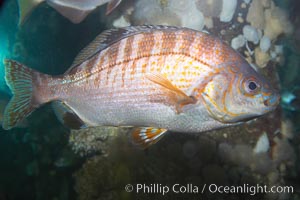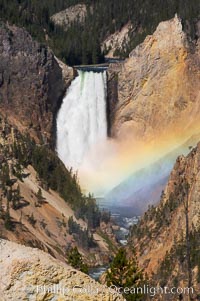
A rainbow appears in the mist of the Lower Falls of the Yellowstone River. At 308 feet, the Lower Falls of the Yellowstone River is the tallest fall in the park. This view is from the famous and popular Artist Point on the south side of the Grand Canyon of the Yellowstone. When conditions are perfect in midsummer, a morning rainbow briefly appears in the falls.
Location: Grand Canyon of the Yellowstone, Yellowstone National Park, Wyoming
Image ID: 13337
Location: Grand Canyon of the Yellowstone, Yellowstone National Park, Wyoming
Image ID: 13337
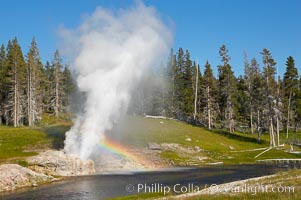
A rainbow appears in the spray of Riverside Geyser as it erupts over the Firehole River. Riverside is a very predictable geyser. Its eruptions last 30 minutes, reach heights of 75 feet and are usually spaced about 6 hours apart. Upper Geyser Basin.
Location: Upper Geyser Basin, Yellowstone National Park, Wyoming
Image ID: 13368
Location: Upper Geyser Basin, Yellowstone National Park, Wyoming
Image ID: 13368
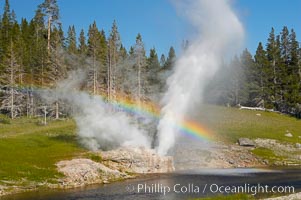
A rainbow appears in the spray of Riverside Geyser as it erupts over the Firehole River. Riverside is a very predictable geyser. Its eruptions last 30 minutes, reach heights of 75 feet and are usually spaced about 6 hours apart. Upper Geyser Basin.
Location: Upper Geyser Basin, Yellowstone National Park, Wyoming
Image ID: 13369
Location: Upper Geyser Basin, Yellowstone National Park, Wyoming
Image ID: 13369

A rainbow appears in the spray of Riverside Geyser as it erupts over the Firehole River. Riverside is a very predictable geyser. Its eruptions last 30 minutes, reach heights of 75 feet and are usually spaced about 6 hours apart. Upper Geyser Basin.
Location: Upper Geyser Basin, Yellowstone National Park, Wyoming
Image ID: 13370
Location: Upper Geyser Basin, Yellowstone National Park, Wyoming
Image ID: 13370

A rainbow forms in the mist from Grand Geyser and Vent Geyser. Grand Geyser is a fountain-type geyser reaching 200 feet in height and lasting up to 12 minutes. Grand Geyser is considered the tallest predictable geyser in the world, erupting about every 12 hours. It is often accompanied by burst or eruptions from Vent Geyser and Turban Geyser just to its left. Upper Geyser Basin.
Location: Upper Geyser Basin, Yellowstone National Park, Wyoming
Image ID: 13452
Location: Upper Geyser Basin, Yellowstone National Park, Wyoming
Image ID: 13452
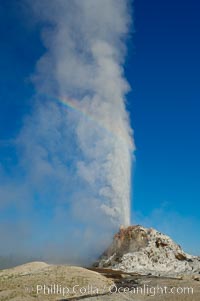
White Dome Geyser, with a faint rainbow visible in its mist, rises to a height of 30 feet or more, and typically erupts with an interval of 15 to 30 minutes. It is located along Firehole Lake Drive.
Location: Lower Geyser Basin, Yellowstone National Park, Wyoming
Image ID: 13541
Location: Lower Geyser Basin, Yellowstone National Park, Wyoming
Image ID: 13541
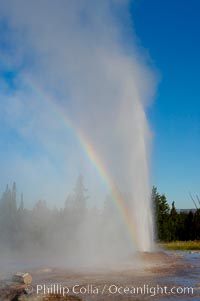
A rainbow appears in the spray of Pink Cone Geyser. Pink Cone Geyser reaches 30 feet in height, and has highly variable interval and duration. It is a cone-type geyser and its cone has a pinkish tint due to manganese oxide in it. Firehole Lake Drive, Lower Geyser Basin, Yellowstone Park.
Location: Lower Geyser Basin, Yellowstone National Park, Wyoming
Image ID: 13549
Location: Lower Geyser Basin, Yellowstone National Park, Wyoming
Image ID: 13549
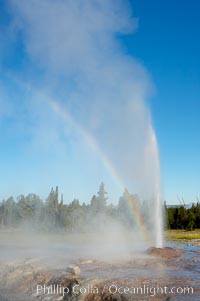
A rainbow appears in the spray of Pink Cone Geyser. Pink Cone Geyser reaches 30 feet in height, and has highly variable interval and duration. It is a cone-type geyser and its cone has a pinkish tint due to manganese oxide in it. Firehole Lake Drive, Lower Geyser Basin, Yellowstone Park.
Location: Lower Geyser Basin, Yellowstone National Park, Wyoming
Image ID: 13553
Location: Lower Geyser Basin, Yellowstone National Park, Wyoming
Image ID: 13553
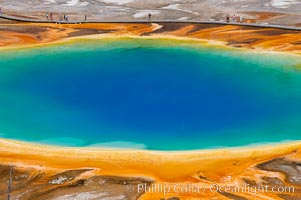
Grand Prismatic Spring displays a stunning rainbow of colors created by species of thermophilac (heat-loving) bacteria that thrive in narrow temperature ranges. The blue water in the center is too hot to support any bacterial life, while the outer orange rings are the coolest water. Grand Prismatic Spring is the largest spring in the United States and the third-largest in the world. Midway Geyser Basin.
Location: Midway Geyser Basin, Yellowstone National Park, Wyoming
Image ID: 13572
Location: Midway Geyser Basin, Yellowstone National Park, Wyoming
Image ID: 13572
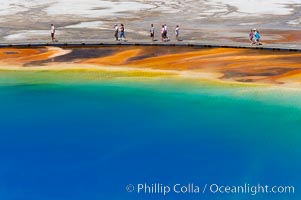
Grand Prismatic Spring displays a stunning rainbow of colors created by species of thermophilac (heat-loving) bacteria that thrive in narrow temperature ranges. The blue water in the center is too hot to support any bacterial life, while the outer orange rings are the coolest water. Grand Prismatic Spring is the largest spring in the United States and the third-largest in the world. Midway Geyser Basin.
Location: Midway Geyser Basin, Yellowstone National Park, Wyoming
Image ID: 13574
Location: Midway Geyser Basin, Yellowstone National Park, Wyoming
Image ID: 13574

Grand Prismatic Spring displays a stunning rainbow of colors created by species of thermophilac (heat-loving) bacteria that thrive in narrow temperature ranges. The blue water in the center is too hot to support any bacterial life, while the outer orange rings are the coolest water. Grand Prismatic Spring is the largest spring in the United States and the third-largest in the world. Midway Geyser Basin.
Location: Midway Geyser Basin, Yellowstone National Park, Wyoming
Image ID: 13575
Location: Midway Geyser Basin, Yellowstone National Park, Wyoming
Image ID: 13575
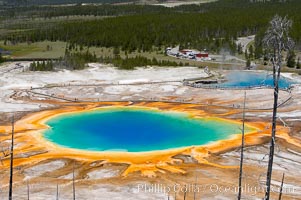
Grand Prismatic Spring (left) and Excelsior Geyser (right). Grand Prismatic Spring displays a stunning rainbow of colors created by species of thermophilac (heat-loving) bacteria that thrive in narrow temperature ranges. The blue water in the center is too hot to support any bacterial life, while the outer orange rings are the coolest water. Grand Prismatic Spring is the largest spring in the United States and the third-largest in the world. Midway Geyser Basin.
Location: Midway Geyser Basin, Yellowstone National Park, Wyoming
Image ID: 13576
Location: Midway Geyser Basin, Yellowstone National Park, Wyoming
Image ID: 13576
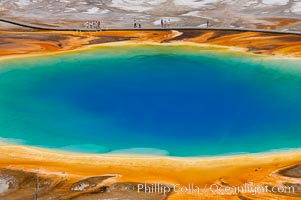
Grand Prismatic Spring displays a stunning rainbow of colors created by species of thermophilac (heat-loving) bacteria that thrive in narrow temperature ranges. The blue water in the center is too hot to support any bacterial life, while the outer orange rings are the coolest water. Grand Prismatic Spring is the largest spring in the United States and the third-largest in the world. Midway Geyser Basin.
Location: Midway Geyser Basin, Yellowstone National Park, Wyoming
Image ID: 13577
Location: Midway Geyser Basin, Yellowstone National Park, Wyoming
Image ID: 13577
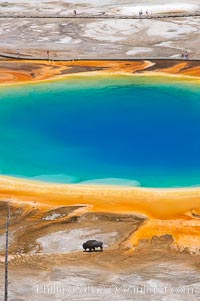
Grand Prismatic Spring displays a stunning rainbow of colors created by species of thermophilac (heat-loving) bacteria that thrive in narrow temperature ranges. The blue water in the center is too hot to support any bacterial life, while the outer orange rings are the coolest water. Grand Prismatic Spring is the largest spring in the United States and the third-largest in the world. Midway Geyser Basin.
Location: Midway Geyser Basin, Yellowstone National Park, Wyoming
Image ID: 13578
Location: Midway Geyser Basin, Yellowstone National Park, Wyoming
Image ID: 13578
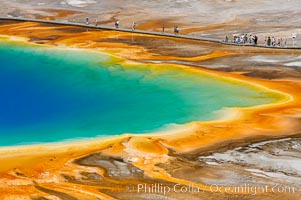
Grand Prismatic Spring displays a stunning rainbow of colors created by species of thermophilac (heat-loving) bacteria that thrive in narrow temperature ranges. The blue water in the center is too hot to support any bacterial life, while the outer orange rings are the coolest water. Grand Prismatic Spring is the largest spring in the United States and the third-largest in the world. Midway Geyser Basin.
Location: Midway Geyser Basin, Yellowstone National Park, Wyoming
Image ID: 13579
Location: Midway Geyser Basin, Yellowstone National Park, Wyoming
Image ID: 13579
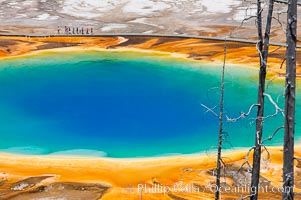
Grand Prismatic Spring displays a stunning rainbow of colors created by species of thermophilac (heat-loving) bacteria that thrive in narrow temperature ranges. The blue water in the center is too hot to support any bacterial life, while the outer orange rings are the coolest water. Grand Prismatic Spring is the largest spring in the United States and the third-largest in the world. Midway Geyser Basin.
Location: Midway Geyser Basin, Yellowstone National Park, Wyoming
Image ID: 13580
Location: Midway Geyser Basin, Yellowstone National Park, Wyoming
Image ID: 13580
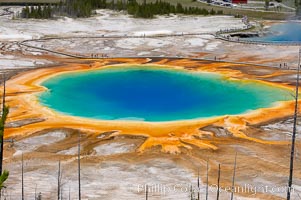
Grand Prismatic Spring (left) and Excelsior Geyser (right). Grand Prismatic Spring displays a stunning rainbow of colors created by species of thermophilac (heat-loving) bacteria that thrive in narrow temperature ranges. The blue water in the center is too hot to support any bacterial life, while the outer orange rings are the coolest water. Grand Prismatic Spring is the largest spring in the United States and the third-largest in the world. Midway Geyser Basin.
Location: Midway Geyser Basin, Yellowstone National Park, Wyoming
Image ID: 13581
Location: Midway Geyser Basin, Yellowstone National Park, Wyoming
Image ID: 13581
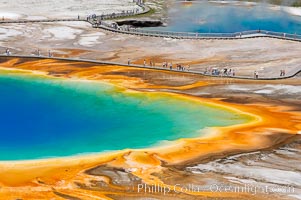
Grand Prismatic Spring displays a stunning rainbow of colors created by species of thermophilac (heat-loving) bacteria that thrive in narrow temperature ranges. The blue water in the center is too hot to support any bacterial life, while the outer orange rings are the coolest water. Grand Prismatic Spring is the largest spring in the United States and the third-largest in the world. Midway Geyser Basin.
Location: Midway Geyser Basin, Yellowstone National Park, Wyoming
Image ID: 13582
Location: Midway Geyser Basin, Yellowstone National Park, Wyoming
Image ID: 13582
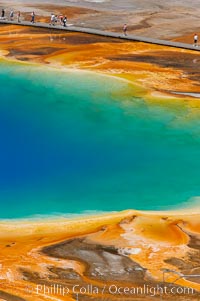
Grand Prismatic Spring displays a stunning rainbow of colors created by species of thermophilac (heat-loving) bacteria that thrive in narrow temperature ranges. The blue water in the center is too hot to support any bacterial life, while the outer orange rings are the coolest water. Grand Prismatic Spring is the largest spring in the United States and the third-largest in the world. Midway Geyser Basin.
Location: Midway Geyser Basin, Yellowstone National Park, Wyoming
Image ID: 13583
Location: Midway Geyser Basin, Yellowstone National Park, Wyoming
Image ID: 13583
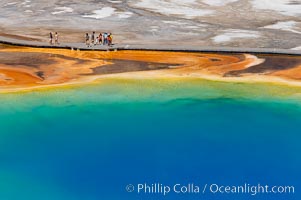
Grand Prismatic Spring displays a stunning rainbow of colors created by species of thermophilac (heat-loving) bacteria that thrive in narrow temperature ranges. The blue water in the center is too hot to support any bacterial life, while the outer orange rings are the coolest water. Grand Prismatic Spring is the largest spring in the United States and the third-largest in the world. Midway Geyser Basin.
Location: Midway Geyser Basin, Yellowstone National Park, Wyoming
Image ID: 13584
Location: Midway Geyser Basin, Yellowstone National Park, Wyoming
Image ID: 13584
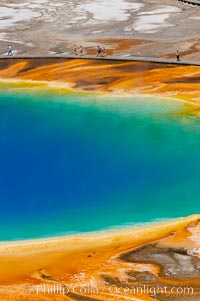
Grand Prismatic Spring displays a stunning rainbow of colors created by species of thermophilac (heat-loving) bacteria that thrive in narrow temperature ranges. The blue water in the center is too hot to support any bacterial life, while the outer orange rings are the coolest water. Grand Prismatic Spring is the largest spring in the United States and the third-largest in the world. Midway Geyser Basin.
Location: Midway Geyser Basin, Yellowstone National Park, Wyoming
Image ID: 13585
Location: Midway Geyser Basin, Yellowstone National Park, Wyoming
Image ID: 13585
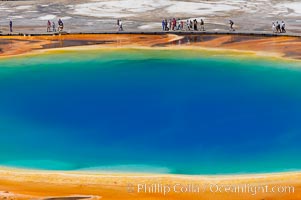
Grand Prismatic Spring displays a stunning rainbow of colors created by species of thermophilac (heat-loving) bacteria that thrive in narrow temperature ranges. The blue water in the center is too hot to support any bacterial life, while the outer orange rings are the coolest water. Grand Prismatic Spring is the largest spring in the United States and the third-largest in the world. Midway Geyser Basin.
Location: Midway Geyser Basin, Yellowstone National Park, Wyoming
Image ID: 13586
Location: Midway Geyser Basin, Yellowstone National Park, Wyoming
Image ID: 13586
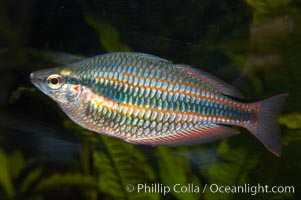
Banded rainbowfish. The banded rainbowfish, from the Goyder River in Australias Northwest Territory, is evolving into a separate species (from other rainbowfishes), has assumed a narrow range and has developed a unique coloration.
Species: Banded rainbowfish, Melanotaenia trifasciata
Image ID: 13964
Species: Banded rainbowfish, Melanotaenia trifasciata
Image ID: 13964

Upper Yosemite Falls by moonlight, viewed from Cooks Meadow. A very faint lunar rainbow (moonbow) can be seen to the left of Yosemite Falls, where the moon illuminates the spray of the falls. Yosemite Valley.
Location: Yosemite Falls, Yosemite National Park, California
Image ID: 16097
Location: Yosemite Falls, Yosemite National Park, California
Image ID: 16097
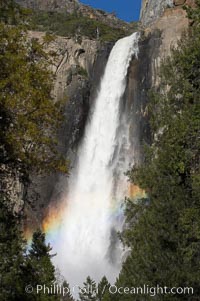
Bridalveil Falls with a rainbow forming in its spray, dropping 620 into Yosemite Valley, displaying peak water flow in spring months from deep snowpack and warm weather melt. Yosemite Valley.
Location: Bridalveil Falls, Yosemite National Park, California
Image ID: 16162
Location: Bridalveil Falls, Yosemite National Park, California
Image ID: 16162
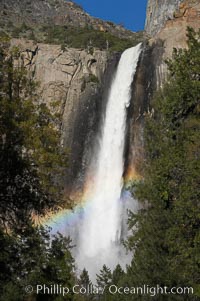
Bridalveil Falls with a rainbow forming in its spray, dropping 620 into Yosemite Valley, displaying peak water flow in spring months from deep snowpack and warm weather melt. Yosemite Valley.
Location: Bridalveil Falls, Yosemite National Park, California
Image ID: 16166
Location: Bridalveil Falls, Yosemite National Park, California
Image ID: 16166
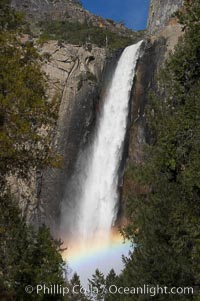
Bridalveil Falls with a rainbow forming in its spray, dropping 620 into Yosemite Valley, displaying peak water flow in spring months from deep snowpack and warm weather melt. Yosemite Valley.
Location: Bridalveil Falls, Yosemite National Park, California
Image ID: 16168
Location: Bridalveil Falls, Yosemite National Park, California
Image ID: 16168
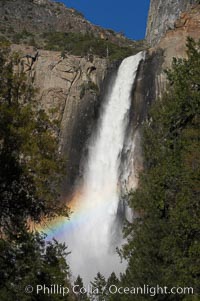
Bridalveil Falls with a rainbow forming in its spray, dropping 620 into Yosemite Valley, displaying peak water flow in spring months from deep snowpack and warm weather melt. Yosemite Valley.
Location: Bridalveil Falls, Yosemite National Park, California
Image ID: 16169
Location: Bridalveil Falls, Yosemite National Park, California
Image ID: 16169
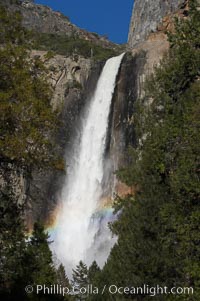
Bridalveil Falls with a rainbow forming in its spray, dropping 620 into Yosemite Valley, displaying peak water flow in spring months from deep snowpack and warm weather melt. Yosemite Valley.
Location: Bridalveil Falls, Yosemite National Park, California
Image ID: 16172
Location: Bridalveil Falls, Yosemite National Park, California
Image ID: 16172
